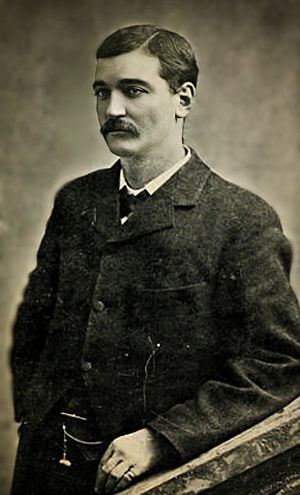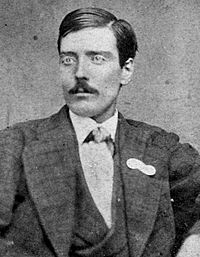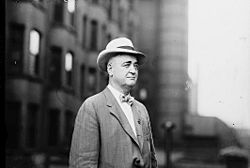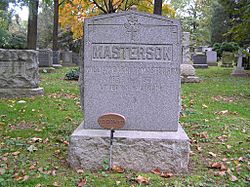Bat Masterson facts for kids
Quick facts for kids
Bat Masterson
|
|
|---|---|

Bat Masterson in 1879, age 26
|
|
| Born | November 26, 1853 Henryville, Quebec, Canada East
|
| Died | October 25, 1921 (aged 67) New York City, U.S.
|
| Resting place | Woodlawn Cemetery in the Bronx, New York City, New York |
| Occupation | Buffalo hunter, U.S. Army scout, lawman (sheriff and U.S. marshal), gunfighter, gambler, journalist |
| Years active | 1872–1900 1908–1912 |
| Parent(s) |
|
| Relatives | James Masterson (brother) Ed Masterson (brother) |
| Signature | |
Bartholemew William Barclay "Bat" Masterson (November 26, 1853 – October 25, 1921) was a famous American scout, lawman, and writer. He was known for his adventures in the American Old West during the late 1800s and early 1900s.
Bat was born in Quebec, Canada, to an Irish family. As a young man, he moved to the American frontier. There, he became known as a buffalo hunter and scout. He later gained fame as a lawman and sheriff in Dodge City, Kansas. He was involved in some famous gunfights during this time.
By the mid-1880s, Masterson moved to Denver, Colorado. He became a professional gambler and took a strong interest in prizefighting (boxing). He became an expert on the sport, attending almost every major boxing match in the United States until he died in 1921.
In 1902, he moved to New York City. He spent the rest of his life working as a reporter and writer for The Morning Telegraph newspaper. His column covered boxing and other sports. He also shared his thoughts on crime, war, and politics. He became a close friend of President Theodore Roosevelt. Roosevelt even gave him a special government job.
When he died in 1921, Masterson was a well-known sports writer and celebrity across the country. Today, people remember him for his connections to many famous people and events of the Wild West. His life is often shown in movies and TV shows.
Contents
Early Life and Family
Bat Masterson was born on November 26, 1853, in Henryville, Quebec, Canada. He was given the name Bartholomew Masterson.
His father, Thomas Masterson, was born in Canada to an Irish family. His mother, Catherine McGurk, was born in Ireland. Bat was the second of seven children. His siblings were Edward John (Ed), James Patrick (Jim), Nellie E., Thomas, George Henry, and Emma Anna. The Masterson children grew up on farms in Quebec, New York, Illinois, and Missouri. The family eventually settled near Wichita, Kansas.
Adventures on the Frontier
When Bat was a teenager, he and his brothers Ed and Jim left their family farm. They went to hunt buffalo on the Great Plains. In 1872, Bat and Ed were hired to help build a railroad track. However, the person who hired them, Raymond Ritter, didn't pay them all the money they were owed.
It took Bat almost a year, but he finally got the money from Ritter. On April 15, 1873, Masterson learned Ritter was coming to Dodge City, Kansas, by train. Bat went into the train car alone and confronted Ritter. He made Ritter pay the $300 he owed to Bat, Ed, and a friend. A large crowd cheered when they saw what happened.
Battle at Adobe Walls
In June 1874, Masterson was hunting buffalo again. He became part of a famous fight in the Wild West called the Second Battle of Adobe Walls. This was a five-day attack by hundreds of Comanche, Kiowa, and Cheyenne warriors. They were led by Quanah Parker. The attack happened at a group of buildings in the Texas panhandle called Adobe Walls.
Masterson was one of only 28 hunters who defended the outpost. The Comanche suffered the most losses in the battle. The exact number killed is not known, but reports say between 30 and 70. The defenders of Adobe Walls lost only four men. After a long fight, Quanah Parker and his followers left.
In August 1874, Masterson became a scout for the U.S. Army. He joined Colonel Nelson Miles. Miles was leading a group from Fort Dodge to chase Comanche and Apache war parties. They went across the Cherokee Strip and into Texas. The group later helped rescue four sisters, aged 9 to 15. They had been captured by a group of Cheyenne warriors. The sisters' family had been attacked in Kansas in September 1874. Their parents, brother, and two older sisters were killed. All four sisters were rescued alive by Miles' group over about six months.
Lawman and Gunfights
Masterson's first gunfight happened on January 24, 1876, in Sweetwater, Texas. He was attacked by a soldier named Corporal Melvin A. King. A woman named Mollie Brennan was accidentally shot and killed during the fight. King died from his wounds. Masterson was shot in the hip but recovered. This injury caused him to use a cane, which became one of his well-known features.
Life in Dodge City
Masterson soon settled in Dodge City. In June 1877, Masterson tried to stop the arrest of a man known as "Bobby Gill." Masterson grabbed the city marshal, Lawrence Edward "Larry" Deger, allowing Gill to escape. Friends of Deger then grabbed Masterson, and the marshal hit him with a pistol. The next day, Masterson was fined $25 for disturbing the peace.
In July 1877, Masterson was hired as an assistant sheriff to Sheriff Charles E. Bassett. Bassett could not run for a third term, so Masterson decided to run for sheriff. His opponent was Larry Deger. On November 6, 1877, Masterson was elected county sheriff of Ford County, Kansas, winning by only three votes. A month later, on December 6, 1877, his brother Ed Masterson became the city marshal of Dodge. So, the Masterson brothers were in charge of the city and county police.
On February 1, 1878, Sheriff Masterson captured the famous outlaws Dave Rudabaugh and Ed West. They were wanted for trying to rob a train. Bat and his brother Ed caught two more train robbers on March 15.
However, this teamwork ended suddenly. On April 9, 1878, 25-year-old City Marshal Ed Masterson was shot and killed while on duty. Ed was badly wounded by a cowboy named Jack Wagner. Bat Masterson was nearby and quickly responded. He fired at both Wagner and Wagner's boss, Alf Walker. Wagner died the next day. Walker was taken back to Texas and recovered. Later, court records showed that Bat Masterson testified under oath that he had shot both men. This suggests he avenged his brother.
More violence happened on October 4, 1878. A performer named Dora Hand was shot and killed by James Kenedy. Kenedy was the son of a rich Texas cattleman. Masterson's group, which included Wyatt Earp and Bill Tilghman, captured Kenedy the next day.
Railroad Conflict in Colorado
Railroad officials asked Sheriff Bat Masterson to gather men. They wanted to fight the forces of another railroad company. The two companies were arguing over who had the right to build tracks through the Royal Gorge in Colorado. Even though Masterson was a sheriff in Kansas and had no authority in Colorado, he gathered a large group of men. This group included famous gunmen like Ben Thompson and Wyatt Earp.
Masterson's involvement ended on June 12, 1879. He surrendered a roundhouse (a building for trains) that his men were holding in Cañon City, Colorado. The "war" between the railroads was finally settled outside of court. Masterson's actions in Colorado did not make the voters of Ford County, Kansas, happy. On November 4, 1879, a bartender named George T. Hinkel defeated Masterson in his re-election bid for sheriff.
The Dodge City War

Masterson's time as city marshal of Trinidad ended just in time for him to help his friend, Luke Short. Short had been forced out of Dodge City by the mayor and Masterson's old enemy, Larry Deger. Within weeks, a group of gunmen gathered by Masterson and Earp came to Dodge City. They came to solve what became known as the "Dodge City War." This gathering resulted in Luke Short being allowed to return to Dodge.
Before they left on June 10, 1883, Short, Masterson, Earp, and five other notable men from the frontier posed for a group photo. This photo was soon called "The Dodge City Peace Commission." It became a famous image of the Old West.
First Try at Journalism
Masterson was back in Dodge City on November 1, 1884. He started a small newspaper called Vox Populi. It focused on local political issues. Three days after it appeared, another Dodge City paper gave it a good review. It said that Masterson was "very promising" as an editor. However, Vox Populi only printed one issue. Almost 20 more years passed before Masterson became a full-time journalist in New York City.
Life in Denver
Masterson eventually left Dodge City and moved to Denver, Colorado. In 1888, he managed and then bought the Palace Variety Theater. It was there that Masterson likely met Emma Moulton, a singer. They later lived together and were reported to have married in Denver in 1891.
Interest in Boxing
Masterson kept his interest in prizefighting and other sports. He was known for often attending boxing matches across the country. He frequently placed bets on the fights. Sometimes, he even worked as an official, like a timekeeper. He knew many heavyweight boxing champions of that time, from John L. Sullivan to Jack Dempsey.
Masterson was at ringside for the John L. Sullivan – Jake Kilrain heavyweight championship fight in Mississippi on July 8, 1889. He was the timekeeper for Kilrain. He also made sure that his friends, Luke Short and Johnny Murphy, were placed around the ring in case of trouble.
In early 1892, Masterson moved to Creede, Colorado, a town known for silver mining. He managed the Denver Exchange gambling club there until the town was destroyed by fire in June 1892. On September 7, 1892, Masterson, Short, and Charlie Bassett attended the Sullivan–Corbett championship fight in New Orleans. Masterson bet on the winner, Corbett.
New York City and Journalism
Masterson and Emma moved to New York City on June 5, 1902. The next day, Masterson was arrested by mistake. Police thought he was involved in a scam. He also had a hidden gun, for which he paid a $10 fine.
A friend, journalist Alfred Henry Lewis, helped Masterson get a job. Lewis's brother, William Lewis, hired Masterson as a writer for his newspaper, the New York Morning Telegraph. His column, "Masterson's Views on Timely Topics," was about sports, especially boxing. The column appeared three times a week from 1903 until his death in 1921.
Alfred Henry Lewis also encouraged Masterson to write stories about his adventures. These were published in Human Life magazine. In 1907, Masterson wrote five stories about famous figures like Ben Thompson, Wyatt Earp, Luke Short, Doc Holliday, and Bill Tilghman. He explained what he thought made a good gunfighter.
Besides writing for the newspaper, Masterson also worked as a timekeeper for many boxing matches. A famous one was the Jack Johnson – Jess Willard title fight in Havana, Cuba, on April 5, 1915. A newsreel from that time shows the 61-year-old Masterson being introduced in that role.
Working for the President
Alfred Henry Lewis introduced Masterson to President Theodore Roosevelt. They became friends, and Masterson often visited the White House. They also wrote letters to each other. President Roosevelt arranged for Masterson to be appointed as a deputy U.S. Marshal for New York.
On February 2, 1905, Roosevelt wrote Masterson a letter. He told Masterson to be careful not to gamble or do anything that might make people criticize his appointment. Masterson worked in this job, earning $2,000 per year, until 1909. Theodore Roosevelt did not run for president again in 1908. The next president, William Howard Taft, did not feel the same way about Masterson. President Taft had an investigation done, and Masterson was fired from his marshal job on August 1, 1909. For the next 12 years of his life, Masterson continued to cover major boxing events for the New York Morning Telegraph.
Final Years and Legacy
On July 2, 1921, Masterson attended his last heavyweight championship fight. It was called the "Million Dollar Gate." In this fight, Jack Dempsey defended his title as heavyweight champion. Three months later, on October 7, silent-screen cowboy star William S. Hart visited Masterson. They were photographed together on the roof of the New York Morning Telegraph building. They then went to Masterson's office, where he asked Hart to sit in his chair for another photo. Hart later said, "Mr. Masterson was sitting in that same chair eighteen days later when he heard the last call."
Death and Burial
On October 25, 1921, at age 67, Masterson died at his desk. He had a massive heart attack after writing his final column for the Morning Telegraph.
His last column included this thought: "I suppose these ginks who argue that ... because the rich man gets ice in the summer and the poor man gets it in the winter, things are breaking even for both. Maybe so, but I'll swear I can't see it that way."
About 500 people attended Masterson's funeral service. Famous friends like Damon Runyon and Tex Rickard were honorary pallbearers. Runyon, a close friend, gave a memorable speech. He said Masterson was "a 100 percent, 22-karat real man." He also said Masterson was "a good hater and a wonderful friend" who always helped those in need.
Masterson was buried at Woodlawn Cemetery in the Bronx, New York. His gravestone is inscribed "William Barclay Masterson" and says he was "Loved by Everyone."
Images for kids
-
Deputies Bat Masterson (standing) and Wyatt Earp in Dodge City, 1876. The scroll on Earp's chest is a cloth pin-on badge.
-
Photograph of the interior of the Long Branch Saloon in Dodge City, Kansas, taken between 1870 and 1885.
See also
 In Spanish: Bat Masterson para niños
In Spanish: Bat Masterson para niños







